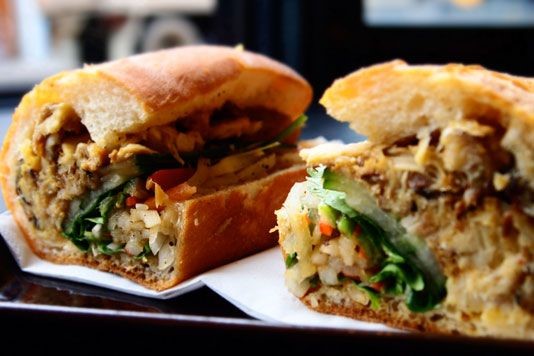Po' boy? bánh mì? Do something different with the humble baguette

The French may have invented the baguette, but others cultures have added their own flavours to create something new. Mina Holland looks at two very different uses for the iconic loaf.
Baguette, the beloved French stick, was developed during the Napoleonic Wars. Rumour has it that the long, thin shape came into being in order to fit down soldiers' trousers. Ooh, I say. No, really. Baguettes actually had a very practical purpose: backpack space was limited and men had to carry food on foot. So what better way than a tubular loaf to slot alongside one's leg?
The baguette was made to travel, and travel it did. This is a bread form that's drifted nomadically to far flung French colonies to create some very local, fusion recipes. I bring you Vietnam's banh mi and the Louisiana Creole sandwich, the po'boy.
Bánh mì
The term “bánh mì” simply means “bread” in Vietnamese, so in Vietnam the mention of other ingredients like Xiu Mai (meatballs) qualify them as sandwiches. Abroad, however, “bánh mì” has become synonymous with a tasty Vietnamese sandwich – rich in flavour but low in stodge.
They are the lovechild of imperial France and colonised Vietnam. Baguettes are filled with traditional Vietnamese flavours like pulled pork, grilled chicken, eggs, tofu, or, in the case of Keu! on London’s Old Street, barbecued mackerel. This utterly delicious latter choice is an innovative twist on conventional versions of the sandwich. The mackerel is infused with lemongrass while it cooks, and then slathered into the baguette with salad, pickled cucumber, daikon radish and coriander. The bread used for making banh mis has changed from that which the French would have taken to Asia. It is lighter, airier on the inside but crusty from without, making extra space for a wad of fillings.
Bánh mì sandwich recipe
Po’Boy
This charmingly named Creole sandwich hails from the southern states of America, though there are several theories about where the moniker originates. Whatever the case, it seems to have been a cheap, quickly-constructed source of sustenance for Louisiana strikers or workers – “poor boys” (naturally shortened to “po’boy” in southern drawl), which has since become a soul food delicacy.
The base for a po’boy is a soft, chunky submarine roll and, like the bánh mì, this can take one of many different fillings. Typically of the south, these are generally fried – either chicken or fruits from the nearby coastline, like shrimps or oysters – and more recent additions to the canon of po’boy fillings include beef and gravy, soft shell crab or even duck.
Dress your sub roll with shredded iceberg, tomato and mayo, and add mustard for meat or Cajun remoulade sauce for fish varieties. Rock ‘n submarine roll.
Have your fill
There’s a sandwich from every corner of the globe and these are only two. As long as there’s bread and filling involved, anything can qualify as a sandwich – as evidenced by South Africa’s Durban Bunny Chow (a loaf of white bread quite literally gutted and filled with curry!), or Scandinavian open sandwiches which, despite only one side of bread, provide a wonderful combination of characterful seeded breads like pumpernickel and memorable flavours like curried herring.
The best thing about sandwich-making is that there are no hard and fast rules; where disciplines like baking are a science, sandwiches are an art. Exercise some creative license and invent your own. One of my favourites is wholemeal pitta with grilled halloumi, avocado and sweet chilli sauce. What are yours?
More sandwiches
Comments
Be the first to comment
Do you want to comment on this article? You need to be signed in for this feature